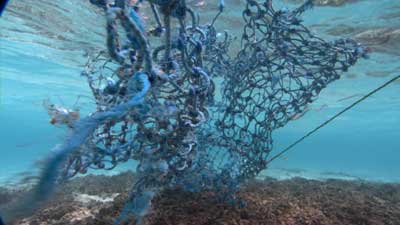|
You
are here: /main/for
teachers /marine debris
For
Teachers
Marine
Debris

Net
removal . Photo by John Brooks, NOAA.
Grades:
3 - 6
Focus Question: What characteristics of trash affect
the likelihood that it will become marine debris?
Lesson at a Glance: Students will perform experiments
to examine if debris will float, or blow in the wind. The
effects of these characteristics on the marine debris are
then discussed.
Key Concepts: Debris that floats or is easily blown
around is more likely to become marine debris. The choices
we make effect the environment.
Objectives: Students will be able to:
1. Define marine debris.
2. Categorize different types of debris.
3. Determine how a material can influence what becomes marine
debris.
Time:
One class period. An extension beach clean-up
Materials:Notebook
or journal to record observations marine debris, deep pan
or sink, fan, water
Teacher Background: Marine debris is trash that is
found in or by the sea. Any object foreign to the marine ecosystem
can be considered marine debris but the term is usually reserved
for human-created trash.
Two
major factors that effect if an item will enter the marine
environment are buoyancy and the ability to be blown by the
wind. As a rule of thumb, if the item can fly and float it
is more likely to enter the marine environment and end up
on our beaches. Plastics readily fly and float, and decompose
very slowly. Not surprisingly, plastics are one of the most
frequently collected type of marine debris.
Negligence
in disposal (from land and sea) is a large cause of the problem.
In 1991 the Center Marine Conservation (CMC) listed the 12
most frequently collected marine debris items as being; 1)
cigarette butts, 2) plastic pieces, 3) foam plastic pieces,
4) plastic food bags and wrappers, 5) paper pieces, 6) glass
pieces, 7) plastic caps and lids, 8) metal beverage cans,
9) glass beverage bottles, 10) plastic straws, 11) plastic
beverage bottles, and 12) foamed plastic cups.
Preparation
and Procedure:
1. A variety of marine debris items should be collected from
local beaches. Glass bottles or worn beach glass (smooth edges)
should be included for the discussion but should not be gathered
by the students to prevent accidents in transportation and
collection.
2. Have the students separate the trash into different piles
(plastic, glass, rubber, metal, paper, wood, and cloth).
3. Have the students address the following questions;
Will the item float or sink?
How do you think that this item ended up in the ocean?
What plants or animals could be effected by the presence of
this item?
4. Test each of the items for buoyancy in the pan. Record
the results.
5. Have the students address the following questions;
Which items do they think will be blown around easily?
Is there a group of items that behaves similarly, (glass or
metal, etc.)?
How far do they think the item can travel?
6. Discuss the impact humans have on their surrounding environment.
Brainstorm ideas about how people can help reduce the amount
debris in our oceans. Every one of us makes daily choices
about products we buy, where to discard trash, and if we want
to help clean up a mess that someone else left. The debris
that is in the marine environment effects different animals
and plants depending on the different material, shape and
size on the item.
Extensions:
Make arrangements for the class to visit a local beach
and conduct a clean-up.
Students can log-on to the NWHI website for journals and picture
updates for more information on marine debris. Do you think
that there will be more debris on the NWHI because so few
people live there or will there be more debris because fewer
people are there maintain the area?
Created
by the Bishop Museum, 2000.
|